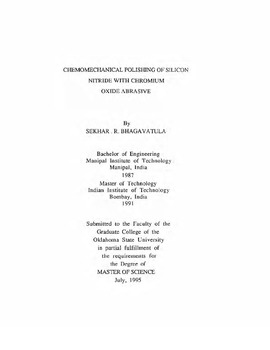| dc.description.abstract | Advan.ced ceramics, such as aluminum oxide, silicon nitride, silicon carbide, and zirconia are difficult to shape and finish, in general, owing to their high hardness and brittleness. With conventional grinding and polishing techniques surface damage is inherently present on the workpiece in the form of pits, and scratches, and subsurface damage in the form of lateral and median cracks. These defects affect the performance and reliability of the products in service. Diamond abrasive is invariably used for grinding as well as for polishing. Consequently, the cost of finishing is high and the time taken for finishing is also significantly long, sometimes taking several weeks. Conventional material removal using abrasives harder than the work material involves abrasion leaving scratches, pitting, and fine cracks on the surface. In contrast, chemo-mechanical polishing (also called mechano-chemical polishing) depends on the chemical interaction between the abrasive, the workmaterial, and the environment. Oftentimes, the abrasives used are about the same hardness or softer than the workmaterial. Consequently, no groove formation is expected with these abrasives leading to a smooth surface. Hence, for finishing advanced ceramics cherno-mechanical action is rather an attractive proposition especially during the final stages of polishing. The chemo-mechanical process initiates a chemical reaction between an abrasive and the work material which have high chemical affinity for each other. The process generally produces a weaker reaction product compared to either the abrasive or the workmaterial the environment used can facilitate this chemical action. The reaction product thus formed is brittle and subsequently removed by the abrasive action. This results in producing a smooth surface. However, the presence of defects such as pits, grooves from an earlier semifinishing operation can still exist in the final operation unless all the defects are removed by this operation. The present investigation focuses on the chemo-mechanical polishing of hot isostatically pressed Si3N4 balls and rollers. Magnetic float polishing technique with a water based magnetic fluid was used for finishing balls and magnetic abrasive finishing technique using magnetic abrasive conglomerate was used for finishing rollers. B4C, SiC, and Cr2O:3 were used as abrasives, with the former two being harder than the silicon nitride workmaterial and the later being about the same or slightly softer than the workmaterial. As will be shown, the material removal mechanism in the latter case is by cherno-mechanical polishing. Si3N4 oxidizes rapidly in air above 1000 ?c. The presence of water enhances oxidation of Si3N4� The surface silica layer formed on Si3N4 during oxidation further reacts with water to form Si(OH)4' This reaction also produces NH3 gas as a byproduct. Thermodynamic analysis confirmed the action of water in enhancing oxidation of Si3N4. Gibb's free energy analysis showed that the reaction proceeds more readily in water up to 500 ?c. Flash temperatures developed at the real areas of contact during polishing were determined using a moving disc heat source model and were found to be in the range of 1200-2000C. | |
